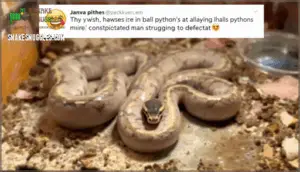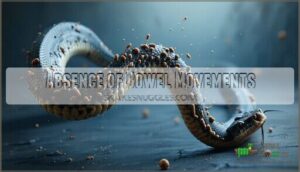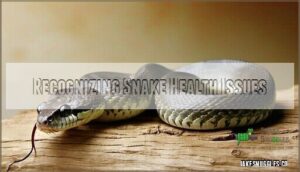This site is supported by our readers. We may earn a commission, at no cost to you, if you purchase through links.

Think of it like a clogged drain—everything backs up behind the blockage. Other common causes include eating oversized prey that’s too large to digest properly, accidentally swallowing substrate materials like sand or wood chips, and inadequate humidity levels that harden feces.
Poor enclosure conditions, including wrong temperatures and insufficient water access, compound these issues.
You’ll notice the telltale signs: a visibly swollen belly, lethargy, and loss of appetite. The good news? Most cases are preventable with proper husbandry, though severe bloating requires immediate veterinary attention to avoid life-threatening complications, which can be caused by dehydration, inadequate humidity levels, poor enclosure conditions, oversized prey, and insufficient water access.
Table Of Contents
- Key Takeaways
- Snake Bloating Causes
- What Causes Snake Bloating
- Snake Impaction Risk Factors
- Signs of Constipation
- Diagnosing Snake Impaction
- Preventing Snake Impaction
- Treating Snake Impaction
- Snake Care and Maintenance
- Recognizing Snake Health Issues
- Managing Snake Health Risks
- Frequently Asked Questions (FAQs)
- Why do snakes have blocked bowels?
- Are snakes constipated?
- Why do snakes eat so much?
- What happens if a snake eats sand?
- How do you know if a snake is constipated?
- Why do snakes eat urate plugs?
- How to help a bloated snake?
- Why does my snake look bloated?
- What causes a hard belly in ball pythons?
- Can snake bloating indicate reproductive issues?
- Conclusion
Key Takeaways
- Dehydration is the main culprit – When your snake does not get enough water or proper humidity (50-60%), waste hardens inside their digestive tract, creating painful blockages that cause visible bloating.
- Poor enclosure conditions compound the problem – Inadequate temperatures, cramped spaces, and wrong substrate choices, such as sand or wood chips, can trigger impaction when your snake accidentally ingests these materials.
- Oversized prey creates digestive disasters – Feeding prey that is larger than your snake’s thickest body section overloads their digestive system and can cause dangerous blockages that lead to bloating.
- Early detection saves lives – Watch for warning signs, such as visible belly swelling, loss of appetite, lethargy, and a lack of bowel movements for over a week; catching these symptoms early prevents life-threatening complications.
Snake Bloating Causes
Snake bloating develops when your pet can’t properly digest food or eliminate waste from their system.
The three primary culprits are dehydration that hardens feces, ingestion of substrate or foreign objects, and cramped enclosures that prevent normal digestive movement, which can be caused by cramped spaces.
Dehydration Effects
Dehydration acts like a slow-motion disaster for your snake’s digestive system.
Dehydration creates a digestive traffic jam that stops your snake cold.
When fluid balance becomes disrupted, waste hardens inside the intestines, creating stubborn blockages that cause painful bloating.
Poor humidity control and limited water access trigger this cascade of problems.
You’ll need proper rehydration methods and consistent humidity levels to prevent impaction-related snake bloating causes.
Ingestion of Non-Food Items
Through careless eating habits, your snake can swallow foreign objects that create serious intestinal blockage.
These non-food items stick in the digestive tract, forming dangerous fecaliths that prevent normal waste elimination.
- Substrate ingestion from sand, walnut shells, or wood chips during feeding
- Towels and fabric accidentally consumed while exploring enclosures
- Gravel and decorative stones that obstruct the intestinal pathway
- Aspen shavings that compact into solid masses causing impaction
- Paper towel pieces that expand and create digestive hazards blocking passage
Inadequate Enclosure Size
Your snake’s cramped quarters create a digestive nightmare.
Tight spaces trap waste, turning your pet’s home into a bloating factory.
Space restrictions prevent natural movement patterns essential for healthy gut function.
When enclosure size limits snake movement, intestinal motility suffers dramatically.
Confinement effects compound with improper environmental temperature and inadequate cage cleaning, creating perfect conditions for snake bloating.
Poor habitat size and husbandry transform your pet’s home into a health hazard.
This situation is a direct result of the confinement and poor care, leading to severe digestive issues.
What Causes Snake Bloating
You’re witnessing your snake’s body swell unnaturally, and that bloating isn’t just uncomfortable—it’s often a medical emergency signaling serious digestive blockages.
Understanding what triggers this alarming condition can mean the difference between a quick recovery and a life-threatening situation that requires immediate veterinary intervention.
Key Challenges Today
Despite advances in reptile care, many snake owners still struggle with outdated husbandry practices that increase bloating risks.
Dehydration risks remain high when humidity levels drop below species requirements. Poor substrate choices lead to impaction causes through accidental ingestion.
Environmental factors like cramped enclosures restrict natural movement, worsening digestive problems.
Without proper health monitoring, snake bloating and reptile digestive issues often go undetected until severe complications develop. Regular checks for snake health issues can help identify potential problems early on.
Future Trends Impact
Through emerging Tech Innovations, you’ll see advanced monitoring systems detecting snake bloating treatment needs earlier.
Climate Change affects reptile digestive issues by altering humidity patterns, while Snake Genetics research reveals predispositions to impaction.
Eco Conservation efforts improve Animal Welfare standards, and new dehydration sensors will revolutionize snake feeding habits monitoring in captive populations.
Innovative Solutions Explored
Modern veterinary innovations are revolutionizing how we tackle snake bloating treatment.
Digital solutions now monitor reptile health issues in real-time, while medical breakthroughs offer targeted therapies for snake digestive problems.
Revolutionary approaches transforming snake rehabilitation:
- Advanced Therapies using targeted enzyme treatments that dissolve impacted waste naturally
- Digital monitoring systems tracking your snake’s feeding habits and digestive patterns 24/7
- Minimally invasive endoscopic procedures removing blockages without major surgery
- Probiotic treatments restoring healthy gut bacteria for better digestion
- Ultrasound-guided therapy precisely targeting bloated snake symptoms for faster recovery
Understanding snake constipation solutions is essential for effective treatment and prevention of digestive issues in snakes.
Snake Impaction Risk Factors
Understanding snake impaction risk factors helps you prevent this serious digestive emergency before it threatens your pet’s life.
Several environmental and dietary conditions substantially increase your snake’s chances of developing life-threatening blockages.
Poor Diet Quality
Your snake’s diet directly impacts its digestive health.
Nutrient Deficiency from low-quality prey creates malnutrition risks that trigger geophagy – your snake eating substrate to seek missing minerals.
Dietary Imbalance reduces gut motility, causing food allergies and digestive issues.
Poor reptile nutrition tips often overlook how improper diet weakens enzymatic efficiency, leading to constipation and bloating from accumulated waste.
Understanding common snake health issues is essential for preventing such problems.
Oversized Prey Consumption
Feeding your snake prey that’s too large creates serious digestive problems and increases impaction risk substantially.
Oversized prey consumption strains your snake’s digestive system, potentially causing bowel obstruction and urate plug formation.
Choose appropriately-sized meals—prey should match your snake’s thickest body section.
Proper prey size prevents digestive blockage while supporting ideal gut health and snake nutrition.
Inadequate Water Access
Your snake’s water provision directly impacts digestive health and bloating prevention.
Dehydration causes hardened waste that blocks intestinal passages, creating dangerous impactions.
Fresh water availability encourages proper snake drinking habits and maintains essential fluid intake.
Poor water quality or limited access disrupts snake hydration, leading to concentrated urates and constipation.
Monitor your snake’s hydration status regularly through skin elasticity and drinking behavior patterns to prevent dehydration.
Low Humidity Levels
When humidity drops below 50%, your snake’s respiratory system can’t maintain proper moisture levels.
Low humidity creates a domino effect that hardens feces internally and increases dehydration risk substantially.
- Dried mucous membranes prevent normal digestion
- Hardened urates block intestinal passages
- Poor shedding cycles indicate humidity control issues
- Respiratory stress compounds existing health problems.
Temperature effects worsen when combined with inadequate air quality and water access limitations.
Signs of Constipation
When your snake shows signs of bloating, lethargy, or hasn’t defecated in over a week, you’re likely dealing with constipation that could progress to dangerous impaction.
These warning signs often appear together and require immediate attention to prevent serious health complications.
Bloating and Lack of Appetite
Your snake’s belly becomes visibly swollen when digestive issues strike, creating unmistakable bloat symptoms that demand immediate attention.
Appetite loss accompanies this distention as dehydration causes fecal matter to harden inside the intestinal tract.
Think of it like a traffic jam in your pet’s digestive system—nothing moves, everything backs up, and feeding problems escalate quickly into dangerous snake constipation requiring prompt veterinary intervention.
Lethargy and Regurgitation
Energy levels drop noticeably when your snake’s digestive system struggles with intestinal blockage.
You’ll spot lethargy signs as your pet becomes unusually inactive, avoiding normal behaviors like exploring or thermoregulating.
Snake stress from digestive problems often triggers regurgitation causes, where undigested food comes back up.
These feeding issues signal serious digestive health concerns requiring immediate attention, which can be linked to intestinal blockage.
Absence of Bowel Movements
Normal defecation patterns become your first line of defense against serious digestive issues.
When constipation strikes, you’ll notice zero bowel movements for 5-10 days after feeding—or longer than your snake’s typical schedule.
This absence signals potential fecal impaction developing in the intestinal tract.
Gut health deteriorates rapidly when bowel blockage prevents waste elimination, creating dangerous pressure buildup that demands immediate attention.
Recognizing snake constipation signs is essential for identifying the underlying cause of the issue, which can lead to immediate attention for your snake’s health.
Diagnosing Snake Impaction
When your snake shows signs of bloating or digestive distress, accurate diagnosis requires systematic veterinary evaluation to identify the underlying cause.
Your vet will use physical examination techniques, advanced imaging, and careful palpation to detect impacted material blocking your snake’s digestive tract.
Physical Examination Techniques
A thorough physical examination reveals critical clues about your snake’s internal condition.
Your vet will use systematic palpation methods and visual inspection to evaluate body condition and detect problems.
- Palpation Methods: Gentle pressure along the abdomen identifies firm masses or abnormal swelling
- Visual Inspection: Looking for distended areas, especially in the lower body third
- Abdominal Checks: Feeling for hardened fecal matter or unusual lumps
- Body Condition: Evaluating overall muscle tone and weight distribution
- Intestinal Blockage: Locating palpable bulges that indicate impaction sites
This hands-on approach improves diagnostic accuracy before advanced imaging.
Radiography and Imaging
Beyond physical examination, radiography serves as your most reliable X-ray diagnosis tool for detecting intestinal blockage.
Modern imaging techniques reveal fecaliths as distinct circular masses on radiographs, while contrast studies enhance fecalith detection accuracy.
Radiographic analysis clearly distinguishes between normal digestive contents and dangerous impaction, making diagnosis straightforward when symptoms seem puzzling, using radiography and contrast studies.
Palpable Bulges and Fecaliths
During examination, you’ll feel firm masses or bulges along your snake’s body where fecal blockage has occurred.
These palpable impactions indicate intestinal obstruction and often feel like hard lumps beneath the skin.
Fecaliths—hardened waste masses—create noticeable abdominal swelling, especially in the lower third of the body.
Urate plugs from bowel problems also produce detectable bumps, signaling serious digestive issues requiring immediate constipation treatment.
Recognizing snake impaction signs is essential for effective treatment and prevention of further complications.
Preventing Snake Impaction
You can prevent snake impaction by maintaining proper enclosure conditions and establishing consistent care routines.
Focus on adequate humidity levels, appropriate temperatures, and regular monitoring of your snake’s feeding and elimination patterns, to ensure proper care and consistent routines.
Proper Enclosure Setup
After identifying impaction through diagnostic methods, preventing future episodes requires careful attention to your snake’s living environment.
Your enclosure setup directly impacts digestive health and can make the difference between a thriving snake and repeated health problems.
Proper snake enclosure design involves considering snake enclosure options to guarantee the best environment for your pet.
- Enclosure Size: Provide adequate space for natural movement and exercise to maintain healthy intestinal motility
- Temperature Gradients: Maintain proper basking and cool zones (species-specific ranges) to support ideal digestion
- Humidity Control: Keep humidity levels at 50-60% to prevent dehydration and fecal hardening
- Substrate Choice: Use safe, non-ingestible bedding like cypress mulch or paper towels instead of sand or walnut shells
Balanced Diet and Hydration
You can’t just toss any meal at your snake and hope for the best.
Proper nutrition means feeding appropriately sized prey – no bigger than your snake’s thickest body part.
Your feeding schedule should match your snake’s age and species needs.
Water intake matters too; fresh water should always be available.
Humidity control supports digestive health by keeping things moving smoothly through their system, and ensuring proper nutrition is key, with fresh water always available.
Regular Observation and Care
Daily observation serves as your first line of defense against snake bloating and digestive issues.
Monitor feeding responses, body condition, and waste production patterns weekly. Maintain detailed health records tracking temperature regulation, humidity levels, and behavioral changes.
Establish consistent care schedules for feeding and enclosure maintenance. Watch for early warning signs like reduced activity or appetite changes—catching problems early prevents serious impaction.
Maintain a routine that includes tracking temperature regulation and monitoring for behavioral changes to ensure the overall health of your snake.
Treating Snake Impaction
When your snake develops impaction, quick action can mean the difference between recovery and serious complications.
Treatment options range from gentle home remedies to emergency surgical procedures, depending on the severity of the blockage.
Hydration Therapy and Warm Water Soaks
When prevention fails, water therapy becomes your snake’s lifeline.
Warm water soaks at 85-90°F for 15-20 minutes daily help restore fluid balance and soften impacted waste.
This rehydration method stimulates bowel movements naturally, making it easier for your snake to pass blocked material.
Think of it as giving your pet a therapeutic spa day that actually saves lives.
Regular snake water soak treatments are essential for maintaining your snake’s overall health and preventing future impaction issues.
Lubricants and Gentle Massages
Beyond warm water baths, you’ll need proper lubricant and massage techniques to encourage bowel movement.
Apply veterinary-approved lubricant around the vent area while providing gentle handling of soft tissue.
Relief Methods for Constipation:
- Massage Techniques – Use circular motions along the belly toward the vent
- Lubricant Types – Water-based options prevent irritation during treatment
- Gentle Handling – Support the snake’s body weight during massage sessions
Surgical Intervention and Post-Op Care
When conservative treatments fail, surgical removal becomes your snake’s lifeline. Veterinarians use radiography to locate fecaliths before anesthesia. The procedure involves careful intestinal repair and fecalith extraction through precise abdominal incisions.
| Phase | Key Actions | Monitoring |
|---|---|---|
| Pre-Op | Radiography confirmation, fasting protocol | Anesthesia risks assessment |
| Surgery | Fecalith extraction, intestinal repair | Doppler monitoring, ECG |
| Recovery | Temperature control, minimal handling | Wound inspection, breathing |
| Post-Op | Pain management, rehydration therapy | Daily behavioral assessment |
| Follow-up | Suture removal (6-8 weeks) | Weight monitoring, feeding |
Post op care demands vigilance, including understanding impacted snake signs. You’ll maintain ideal temperature and humidity while monitoring for postoperative complications like infection or dehiscence. Pain management with meloxicam helps recovery, but feeding waits until normal swallowing returns.
Snake Care and Maintenance
Proper snake care prevents bloating by maintaining the right environmental conditions and feeding practices that support healthy digestion.
You’ll need to monitor temperature gradients, humidity levels, and water availability while following appropriate feeding schedules to keep your snake’s digestive system functioning normally, which is crucial for healthy digestion and overall snake care.
Maintaining Proper Temperature Gradients
Three essential heat sources create proper temperature gradients your snake needs for healthy digestion.
Establish basking temperatures between 88-92°F while maintaining cool zones around 78-82°F through careful temperature control.
Low temperature environments slow metabolism and harden waste, leading to dangerous impaction.
Use thermostats for precise temperature regulation and monitor thermal gradients across climate zones within your enclosure daily.
Accurate thermostat devices, such as those using smart home systems, can help maintain ideal temperatures.
Humidity Levels and Water Access
Ideal humidity levels between 50-60% prevent dehydration, while constant water access supports proper hydration therapy.
Poor water quality and inadequate humidity control directly cause digestive blockages.
Monitor enclosure maintenance daily—your snake’s hydration status determines whether waste moves smoothly or hardens into dangerous impactions.
Temperature regulation works hand-in-hand with moisture to maintain healthy elimination patterns.
Feeding Schedules and Prey Size
Proper prey selection and feeding frequency prevent digestive complications that lead to bloating.
You’ll maintain your snake’s health through consistent meal timing and appropriate food quality.
Essential feeding guidelines include:
- Prey size – Choose items 10-15% of your snake’s body weight
- Feeding frequency – Adult snakes eat every 2-3 weeks, juveniles weekly
- Portion control – One appropriately-sized meal prevents overloading digestion
- Food quality – Fresh or properly thawed prey supports ideal snake digestion
Recognizing Snake Health Issues
You’ll notice your snake’s health declining through three key warning signs that demand immediate attention.
Weight loss paired with feeding refusal, visible straining during defecation attempts, and persistent lethargy signal serious digestive blockages.
These blockages can quickly become life-threatening without prompt veterinary intervention.
Weight Changes and Feeding Problems
Weight changes and feeding problems often signal underlying snake health issues.
Appetite changes, weight loss, and digestive problems can indicate serious conditions requiring immediate attention. Monitor your snake’s eating patterns carefully.
| Issue | Signs | Action |
|---|---|---|
| Appetite Changes | Refuses food, selective eating | Check temperature, reduce stress |
| Weight Loss | Visible spine, muscle wasting | Increase feeding frequency, vet visit |
| Digestive Problems | Regurgitation, irregular feeding | Adjust prey size, monitor hydration |
| Nutrition Deficits | Poor growth, lethargy | Review diet quality, supplement needs |
Snake bloating often accompanies feeding issues and snake constipation. Track feeding frequency and weight changes weekly to catch problems early.
Visible Discomfort and Straining
Beyond weight and feeding changes, you’ll notice your snake showing clear signs of physical distress.
When impaction strikes, snakes exhibit unmistakable straining behavior and visible bloating that signals serious digestive blockage requiring immediate attention.
Visible Discomfort and Straining Signs:
- Abdominal Swelling – Firm, distended belly especially in the lower third of your snake’s body
- Straining Behavior – Unusual pushing movements or positioning near the vent area during attempted defecation
- Visible Bloating – Noticeable enlargement that feels harder than normal when gently palpated
- Discomfort Signs – Restlessness, unusual coiling positions, or reluctance to move normally
- Digestive Blockage Indicators – Palpable masses along the body combined with unsuccessful elimination attempts
These symptoms often accompany dehydration and constipation, creating a dangerous cycle. Your snake’s body language tells the story – watch for that telltale "trying too hard" posture that screams impaction trouble ahead.
Loss of Appetite and Lethargy
When appetite loss pairs with lethargy signs, your snake’s sending a clear SOS signal.
These digestive issues often indicate snake bloating, constipation, or dehydration brewing beneath the surface.
Watch for sluggish snake behavior—if they’re refusing meals and moving like they’re underwater, health decline may be accelerating rapidly, signaling a potential case of dehydration.
Managing Snake Health Risks
Proper snake care management requires consistent monitoring and proactive health measures to prevent serious complications like impaction.
You’ll need to establish regular routines for weight tracking, hydration assessment, and veterinary consultations to catch problems before they become life-threatening, which is crucial for proactive health measures.
Reducing Stress and Handling
Excessive stress weakens your snake’s immune system and disrupts normal digestive processes, potentially triggering snake bloating.
Gentle handling techniques involve supporting their body weight and moving slowly to avoid startling them. Limit handling sessions to 10-15 minutes, especially after feeding.
Environmental enrichment like hiding spots and proper temperature regulation reduces anxiety.
Remember, a stressed snake won’t eat properly, creating a cycle that worsens husbandry problems.
Monitoring Weight and Hydration
Regular Weight Tracking and Scale Monitoring help you catch snake bloating early.
Weekly weigh-ins reveal sudden weight gain that signals impaction or dehydration issues.
Monitor Body Condition by checking for firm belly swelling.
Guarantee adequate Fluid Intake through fresh water access and proper humidity levels.
Consistent Hydration Tips include maintaining 60-80% humidity to prevent dangerous dehydration complications, and it is crucial for Regular Weight Tracking to identify issues early, ensuring proper humidity levels are maintained.
Regular Veterinary Check-Ups
Schedule annual veterinary check-ups to catch snake bloating and constipation relief issues early.
Reptile health care specialists detect problems your eyes might miss—like hidden parasites or developing impaction.
These vet visits aren’t just checkups; they’re your snake’s insurance policy against serious snake health problems.
Think of your reptile veterinarian as your snake’s personal health detective, spotting trouble before it becomes expensive emergency veterinary care, providing constipation relief.
Frequently Asked Questions (FAQs)
Why do snakes have blocked bowels?
Blocked bowels affect 15% of captive snakes annually.
You’re dealing with impacted feces when your snake can’t defecate due to dehydration, substrate ingestion, or inadequate temperatures.
Poor husbandry creates this uncomfortable backup, which can be understood by recognizing impacted feces and poor husbandry as key issues.
Are snakes constipated?
Yes, snakes can become constipated when they can’t pass waste normally.
Dehydration, improper temperatures, substrate ingestion, and oversized prey commonly cause this digestive issue.
Leading to uncomfortable bloating and health risks.
Why do snakes eat so much?
Coincidentally, you’re wondering about snake appetite right after discussing impaction—it’s actually their slow metabolism that makes them seem ravenous.
Snakes don’t eat frequently, but when they do, they’ll consume large prey because their digestive system efficiently processes infrequent, substantial meals, which is related to their digestive system.
What happens if a snake eats sand?
When your snake eats sand, it can’t digest or pass the gritty particles, causing substrate impaction.
This creates dangerous blockages in their digestive tract, leading to constipation, bloating, and potentially life-threatening complications requiring veterinary intervention.
How do you know if a snake is constipated?
Like watching paint dry in reverse, you’ll notice your snake hasn’t defecated for 5-10 days after eating.
It shows visible bloating in the lower body, displays lethargy, loses appetite, and may strain near the vent area.
Why do snakes eat urate plugs?
Snakes don’t intentionally eat urate plugs. These hardened waste deposits form from dehydration and poor kidney function, then block their digestive tract. You’ll see this as constipation requiring veterinary treatment.
How to help a bloated snake?
Imagine your snake’s digestive system as a clogged drain pipe that needs gentle coaxing to flow again.
You’ll need to provide warm water soaks, gentle belly massages, and adjust enclosure humidity and temperature to help relieve the blockage safely.
Why does my snake look bloated?
Your snake’s bloated appearance typically results from constipation or impaction caused by dehydration, inadequate temperatures, substrate ingestion, or oversized prey blocking the digestive tract.
What causes a hard belly in ball pythons?
Unlike a soft, healthy abdomen, your ball python’s hard belly signals serious digestive trouble. You’re likely dealing with impaction from substrate ingestion, dehydration, or constipation blocking their intestinal tract completely.
Can snake bloating indicate reproductive issues?
Yes, snake bloating can indicate reproductive issues.
Egg-bound females often develop visible abdominal swelling when they can’t pass eggs naturally.
You’ll notice firm, round masses that feel different from typical impaction bloating, which can be a sign of reproductive issues.
Conclusion
Understanding what causes snake bloating could mean the difference between a routine care adjustment and an emergency vet visit.
Dehydration remains the primary culprit, creating urate plugs that block your snake’s digestive system like a stubborn drain clog.
Poor humidity, oversized prey, and substrate ingestion also contribute substantially to the issue of snake bloating.
You’ll spot the warning signs early: visible swelling, appetite loss, and unusual lethargy.
With proper enclosure conditions, appropriate feeding schedules, and adequate hydration, you can prevent most bloating episodes before they become serious health threats.
- https://www.petplace.com/article/reptiles/general/lumps-and-bumps-in-snakes
- https://www.reddit.com/r/cornsnakes/comments/14ua5dr/11_month_old_corn_snake_has_swollen_stomach_all/
- https://www.ingleside.com/services/other-pets/blog/common-health-problems-pet-snakes
- https://www.addl.purdue.edu/newsletters/1996/summer/snakes.shtml
- https://www.merckvetmanual.com/exotic-and-laboratory-animals/reptiles/parasitic-diseases-of-reptiles


















